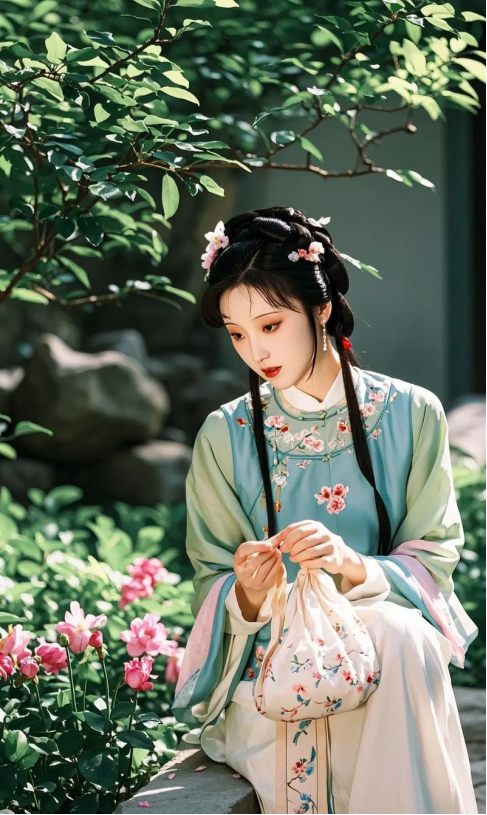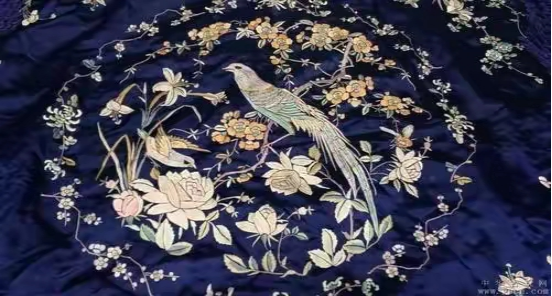People who love Hanfu are mostly familiar with many styles of Hanfu, such as collars, robes, belts, dieyi, ruqun, etc., which are relatively common Hanfu garments. However, there is another garment that is less understood and seen in daily life, and that is the cape. Some people may wonder: Is the cape mentioned here different from the modern cape? Is it the same as the cape we usually come into contact with? These questions are normal. In fact, the purpose and form of Hanfu capes are very different from those of modern capes.

Modern capes are mostly just a layer of fabric used to cover the shoulders, mainly to resist the cold for a while, with a single style and no gorgeous decorations. While the Hanfu cape has sleeves. It is a single garment with sleeves added on the basis of regular clothes. Although the Hanfu cape also has the function of resisting the cold, it is more for the sake of etiquette and beauty, and at the same time has practicality, being one of the overall elements of Hanfu.

What Was the Style of the Cape from the Han Dynasty to the Tang Dynasty?
The shape of the Hanfu cape can be traced back to the “peibo” in the Han Dynasty. The “peibo” was a single garment made of silk added to the clothes, generally worn on important occasions. There were many changes in the patterns on it, such as auspicious cloud patterns, ruyi patterns, and golden silk edges, etc., which could reflect the sense of grace and luxury brought by the cape. In the Tang Dynasty, the cape developed into a flowing peibo. At this time, the cape had a great change. A wisp of peibo made of real silk was sandwiched under the armpit and by the hand of the woman. With the woman’s graceful figure and steady steps, a wisp of floating fairy air came into being, showing the woman’s elegance and freedom incisively and vividly.

What Was the Style of the Cape in the Song and Ming Dynasties?
By the Song and Ming Dynasties, the cape gradually matured, and a relatively fixed style appeared. The cape was shaped into a long coat with a front-facing straight collar and side slits. Worn on women in layers, it showed the noble temperament of women incisively and vividly. At that time, techniques such as gold-threaded brocade and embroidery were used, and some nobles even used gray squirrel hair and fox fur as edges, making it a symbol of status and position. The cape paid attention to etiquette, and the design of slits and front-facing was often retained in the structure, which was an important part of the Hanfu design aesthetics.

What Are the Popular Styles of Hanfu Capes Now?
The more popular styles nowadays are mainly the Ming-style and Song-style capes. The Ming-style cape is generally characterized by front-facing and side slits, with a close-fitting collar. It is mostly made of cloud brocade and satin. The patterns mostly use dragon and phoenix, tangled branches and flowers, and are matched with gold-threading technology. The style is mostly noble and grand, and the colors are mainly neutral and dark colors, such as blue and lotus root powder. Wearing it with a Ming-style mian skirt, it is as if you have instantly traveled back to the prosperous scene of the Ming Dynasty.

The Song-style cape is mainly the beizi-style cape, which is characterized by being light, thin and breathable, with relatively wide cuffs, fitting the outer clothes. It is suitable for wearing in hot spring and summer weather. It is mainly made of real silk, and is matched with a moxiong (chest wrap) and a hundred-fold skirt, which has the beautiful feeling of elegance and coolness in the Song Dynasty.
The classical charm of the Hanfu cape is obvious. Wearing it on the body can play an excellent role in adding beauty to the good. It has always had the effect of “starting from clothes and reaching far into the distance”. Nowadays, whether in the grand hall of gatherings or in the personal mixed wear of the city, the cape has always connected tradition and modernity with an inclusive attitude. It has always existed in our lives. The Hanfu cape is worthy of our good treatment, inheritance, and good appreciation of its beauty.







